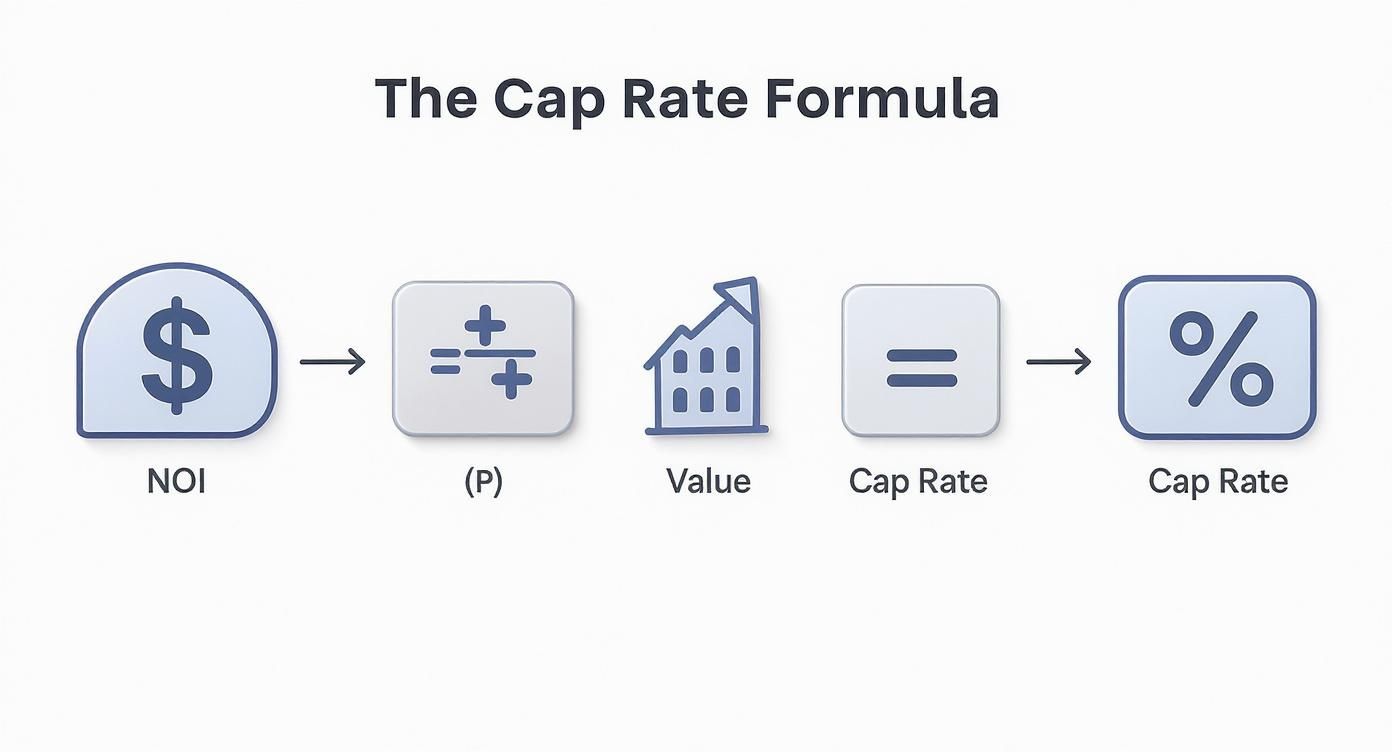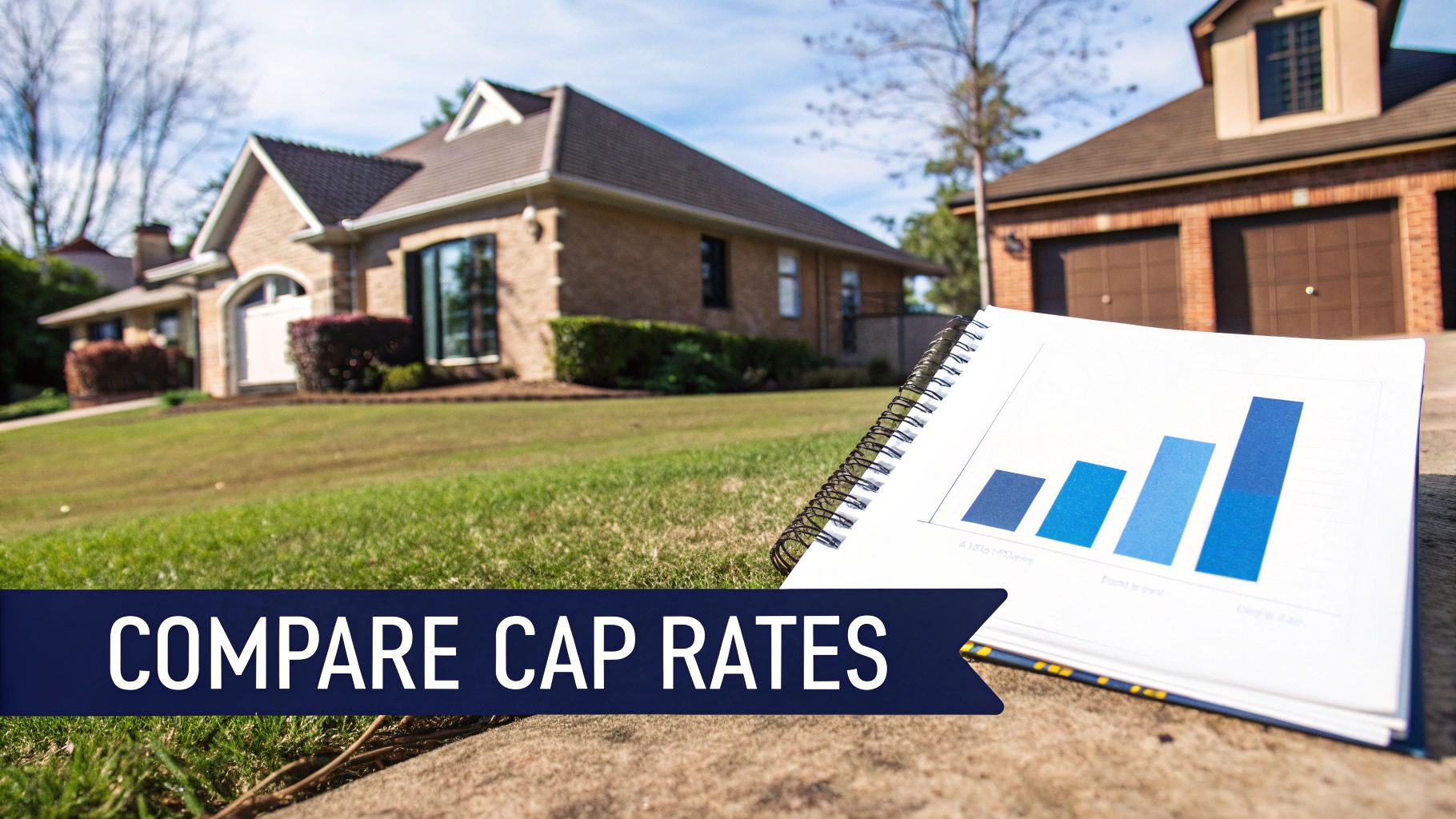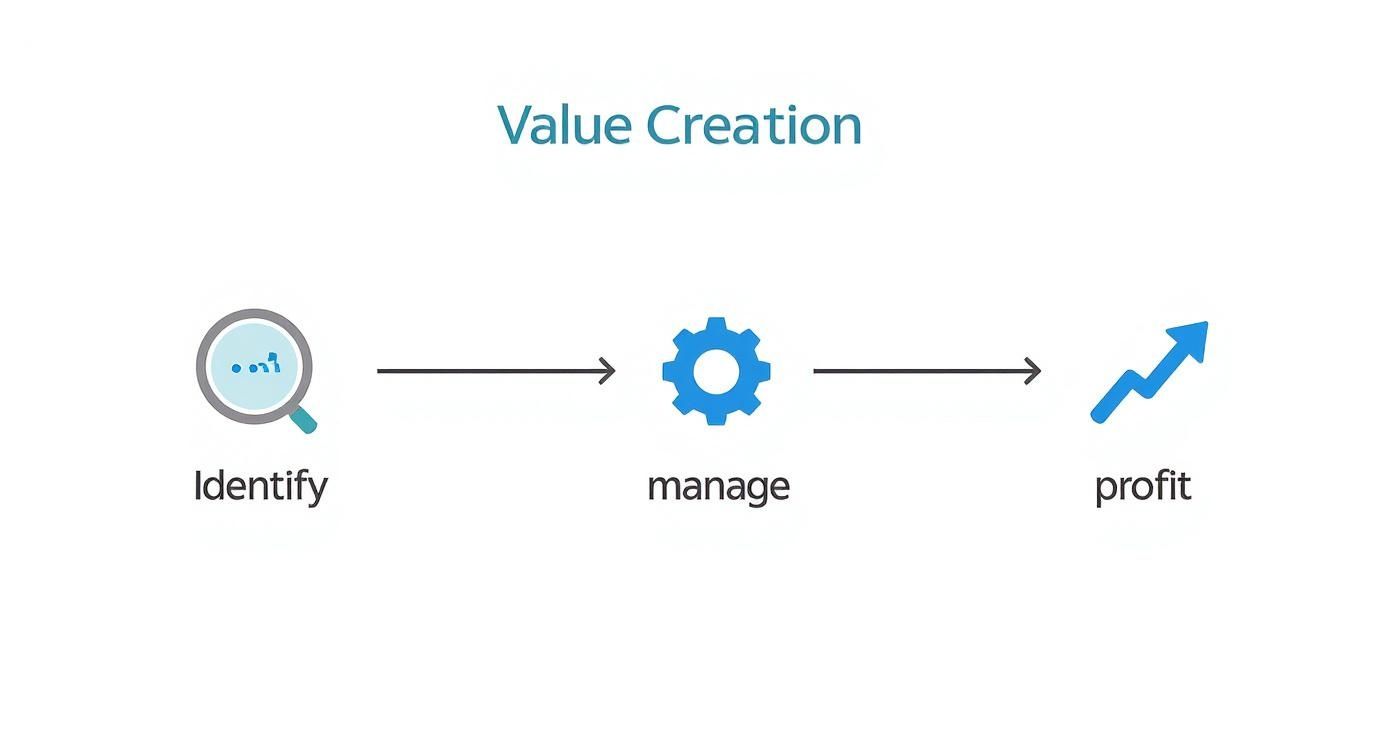Reading Time: 8 min | Good for Investor Personas: A, B
TL;DR: Key Takeaways
Core Difference: The choice between an open-ended fund vs closed-ended fund boils down to liquidity and capital structure. Open-ended funds offer daily or quarterly liquidity, while closed-ended funds lock in capital for a long-term strategy, typically 5-10 years.
Best Fit for Strategy: Closed-ended funds are the institutional standard for illiquid, long-term real estate strategies like development and value-add projects. Open-ended funds are better suited for stable, liquid, "core" real estate assets.
Valuation Nuance: Open-ended funds transact at Net Asset Value (NAV). Closed-ended funds trade on a secondary market, meaning their share price can be at a discount or premium to NAV, creating both risk and opportunity for savvy investors.
Investor Take: Your investment goals dictate the right structure. If you need liquidity, an open-ended fund may work. If you are targeting higher returns from complex projects and can commit capital for the long haul, a closed-ended fund is the more robust and strategically aligned choice.
At its heart, the main difference between an open-ended fund and a closed-ended fund comes down to two things: liquidity and capital structure. Think of open-ended funds, like most mutual funds you're familiar with, as having a revolving door—they’re constantly issuing new shares and buying back old ones at their Net Asset Value (NAV). This gives investors a lot of flexibility to get their money in and out.
On the flip side, closed-ended funds are more like a private club with a fixed number of memberships. They raise a set amount of cash in an initial offering, issue a fixed number of shares, and that’s it. After that, those shares trade on an exchange just like stocks, with prices moving based on what the market is willing to pay.
Defining the Investment Vehicles
For any investor looking at private real estate deals, getting a handle on the fund structure is just as important as scrutinizing the properties themselves. Whether you choose an open-ended or a closed-ended fund shapes how you invest, when you can cash out, and how the fund manager can even approach their strategy. This isn't just a technicality; it's a core driver of your risk and potential returns.
An open-ended structure is built for nimbleness. Capital can flow in and out, which is perfect for strategies centered on stable, income-generating assets that are relatively easy to buy and sell.
A closed-ended fund, however, provides a locked-in, stable pool of capital. This "patient capital" is absolutely crucial for long-term, illiquid projects like ground-up development or major value-add renovations. A manager needs to know they have years to execute their business plan without worrying about a sudden rush of investors wanting their money back.

Key Differences at a Glance: Open Ended vs Closed Ended Funds
To really spell out what this means for you as an investor, let's break down the practical differences. The table below cuts straight to the features that will impact your experience and your wallet.
Feature | Open-Ended Fund | Closed-Ended Fund |
|---|---|---|
Capital Structure | Flexible. The fund’s size ebbs and flows as investors buy in or cash out. | Fixed. A set amount of capital is raised once, creating a finite number of shares. |
Share Issuance | The fund itself is always creating new shares for buyers and redeeming them for sellers. | A limited number of shares are sold during an initial public offering (IPO). |
Liquidity | Generally high. You can usually redeem your shares directly with the fund, often daily or quarterly. | Very low. To get out, you have to find another investor to buy your shares on a secondary market. |
Pricing | Shares are priced right at the fund's Net Asset Value (NAV) per share. Simple and direct. | The share price is all about market supply and demand. It can trade at a premium or a discount to its NAV. |
Best Fit For | Liquid assets, like publicly-traded stocks or stabilized, core commercial real estate. | Illiquid assets that need time to mature, like private equity or value-add real estate projects. |
At the end of the day, neither structure is flat-out better than the other. The real key is finding the right fit. You need to align the fund’s mechanics with both the manager’s investment strategy and your own personal goals for liquidity and long-term growth.
Understanding Fund Mechanics: Capital Flow and Liquidity
To really get the difference between open-ended and closed-ended funds, you have to look under the hood at how money moves. The mechanics of capital flow and liquidity aren't just technical jargon; they're the engine that dictates a fund's entire strategy, its stability, and whether it’s the right fit for your portfolio.
At its core, the distinction is all about how each fund handles investor demand. One is built to expand and contract as needed, almost like a public utility. The other is constructed like a fortress, designed to protect a long-term mission from the whims of the market.
Open-Ended Funds: The Revolving Door
An open-ended fund is defined by its perpetual nature. It’s always offering new shares to investors and, at the same time, stands ready to buy back (redeem) existing shares. This creates a highly dynamic capital pool that can swell or shrink on a daily basis.
When you invest, the fund literally creates new shares just for you. When you want to cash out, it retires those shares and pays you from its cash reserves.
For investors, this structure offers one massive advantage: liquidity. Most of the time, you can redeem your shares directly from the fund daily or quarterly, getting a price based on its Net Asset Value (NAV)—the real, underlying worth of all its assets.
But this constant ebb and flow creates a huge challenge for the fund manager, especially when the fund holds illiquid assets like real estate. To handle potential redemptions, the manager has to keep a "liquidity buffer," a chunk of the portfolio sitting in cash or other easy-to-sell securities. That cash sitting on the sidelines can create a serious drag on performance.
Novice Lens: Why It MattersThink of an open-ended fund like a checking account. You can deposit and withdraw money easily, but the bank has to keep a lot of cash on hand to meet those withdrawals, meaning it can't invest all of it for higher returns. This need for liquidity makes these funds a better fit for assets that can be sold quickly, not for long-term construction projects.
Closed-Ended Funds: The Fixed Capital Fortress
A closed-ended fund is a completely different animal. It raises a specific amount of capital during an initial offering and then, as the name implies, "closes" the door to new money. The number of shares is fixed, and that capital is locked in for the entire life of the fund, often for a decade or more.
Once that initial offering is over, you can't go back to the fund to sell your shares. Instead, you have to find a buyer on a secondary market, much like a stock exchange. This creates an entirely different dynamic where the share price is driven by supply and demand, not just the fund's underlying NAV.
This fixed structure gives the manager a stable, predictable pool of what we call "patient capital." They can put 100% of the money to work in long-term, illiquid strategies—like developing a new multifamily community or repositioning a data center—without the looming threat of sudden investor withdrawals forcing a fire sale of assets.
Interestingly, closed-end funds have been around in the U.S. longer than their open-ended cousins, with the first open-end fund launching in 1924. Because their fixed share count makes them subject to market sentiment, their prices can swing wildly from their underlying NAV. We've seen some extreme valuations, including premiums soaring over 1,200% back in 1929. Today, the average U.S. fund trades at a discount of about 9%. You can explore more on these historical pricing dynamics to see just how much of a role market psychology plays.
Valuation and Returns: NAV vs Market Price Dynamics
How you actually make money from a fund is deeply connected to how its assets are valued. When you’re comparing an open-ended fund to a closed-ended one, the valuation method is one of the most important distinctions, creating totally different risks and opportunities.
One fund structure is tied to a precise, calculated value. The other gets tossed around on the unpredictable waves of market sentiment.

Open-Ended Funds and NAV Precision
For open-ended funds, things are pretty straightforward. Every transaction—whether you’re buying shares or cashing out—is done at the fund’s Net Asset Value (NAV) per share.
NAV is simply the current market value of all the fund's assets, minus any liabilities, all divided by the number of shares out there. It’s the "true" underlying worth of your piece of the pie, usually calculated every single day.
This direct link to NAV gives investors a ton of transparency and predictability. But it also creates a major constraint. To be able to pay out redemptions at NAV on short notice, the fund has to own assets that are easy to value and sell quickly. This naturally pushes open-ended funds toward more liquid, stable real estate.
Closed-Ended Funds: The Market Price Dance
This is where things get interesting. Closed-ended funds also calculate a NAV, but the price you actually pay or receive is set by whatever the market decides your shares are worth on a secondary exchange.
And that market price can—and often does—drift away from the fund’s NAV.
Trading at a Discount: When the market price is lower than the NAV, the fund is trading at a discount. This might happen because of shaky fund performance, a pessimistic market, or investors getting nervous about the fund's illiquid assets.
Trading at a Premium: When the market price is higher than the NAV, it’s trading at a premium. This could be fueled by intense demand for a particular strategy, a star fund manager, or a general belief that the NAV isn’t capturing the fund's full future potential.
It’s in this gap between market price and NAV where savvy investors start looking for opportunities.
Insight Edge: The Alpha in the DiscountA significant discount to NAV can be a powerful source of alpha for sophisticated investors. An investor might scoop up shares at, say, $0.85 on the dollar compared to what the underlying assets are actually worth. Suddenly, your potential return is coming from two places: the performance of the assets themselves, and the chance for that discount to shrink over time as the market gets more optimistic. It creates an extra layer of potential return, but it also brings market risk—a discount can always get wider before it gets smaller.
Unpacking Discounts and Premiums
So why does this gap between NAV and market price even exist? It's a messy combination of hard numbers and human emotion. Several factors can widen or shrink that spread:
Market Sentiment: In a downturn, fear can hammer share prices much harder than the actual value of the assets has fallen, creating huge discounts.
Asset Illiquidity: If a fund holds complex private assets that are hard to value, investors might demand a discount to compensate for that uncertainty and lack of liquidity.
Anticipated Performance: A fund run by a legend with a killer track record might trade at a premium because investors are essentially "pricing in" their high expectations for future wins.
Embedded Capital Gains: If a fund is sitting on massive, unrealized capital gains, it might trade at a discount because new investors know they’ll eventually inherit a tax bill.
Getting a handle on these dynamics is key. For another angle on valuation, especially for long-term projects, it can be useful to know how to calculate Net Present Value (NPV) of an investment using Excel. It's another tool for figuring out the intrinsic value of future cash flows, a core concept for both NAV and market price. At the end of the day, this constant dance between NAV and market price is what defines the entire closed-ended fund experience.
Matching Fund Structure to Real Estate Strategy
Choosing between an open-ended and a closed-ended fund isn't just a technical detail—it's a critical decision that has to mesh perfectly with the real estate strategy. Think of the fund structure as the foundation of a building. If it’s not right for the design, the whole project is at risk.
A mismatch between the two can cause serious problems, forcing bad decisions and ultimately hurting returns. For investors, understanding this alignment is key. It tells you if the manager has the right vehicle for the road ahead.
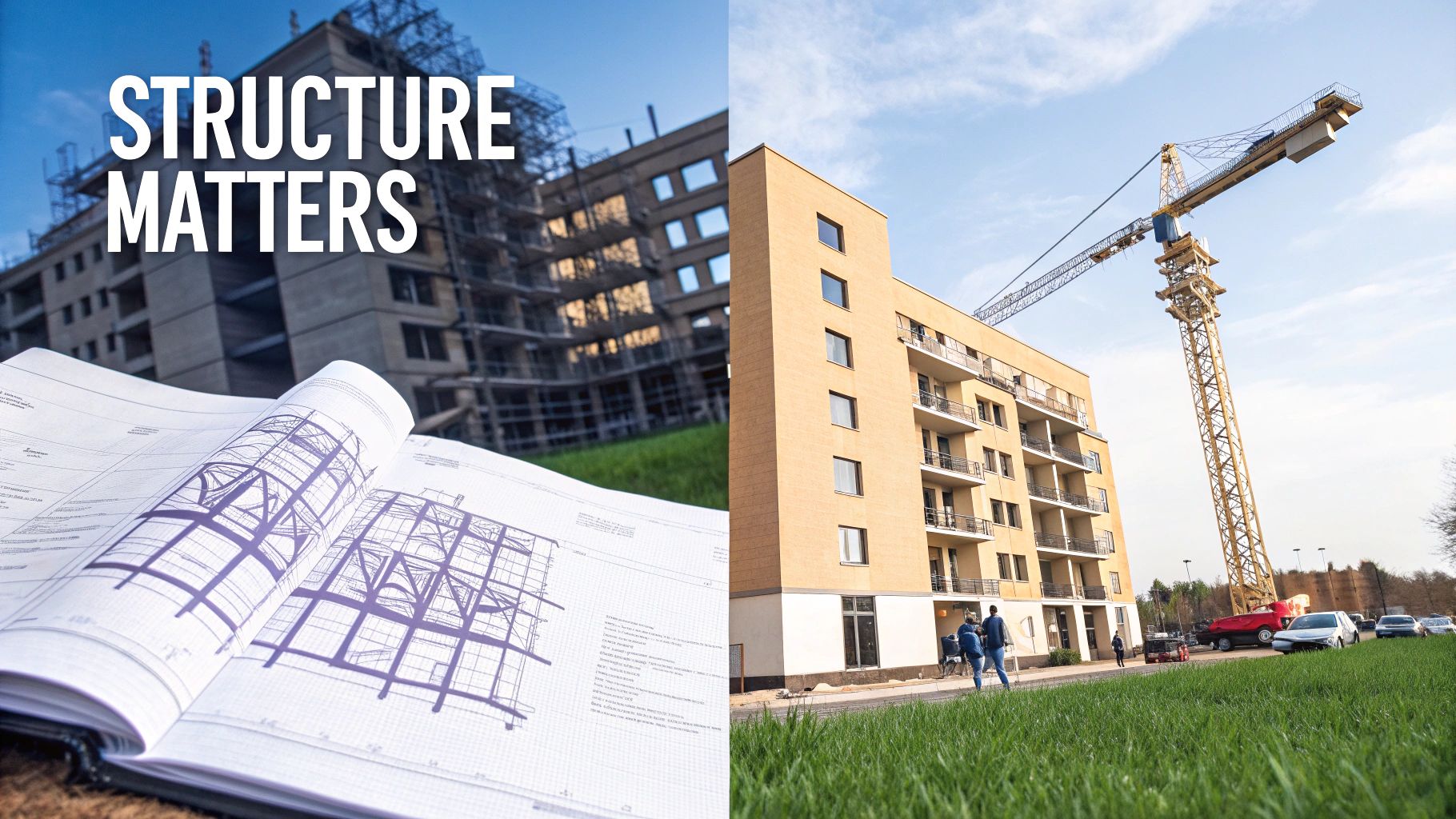
Why Closed-Ended Funds Dominate Value-Add and Development
When it comes to strategies that involve building, renovating, or repositioning properties, the closed-ended structure is king. These projects are, by nature, illiquid and need a long, uninterrupted runway to succeed.
Take a ground-up multifamily development. The timeline involves:
Acquisition and Entitlement: Buying land and navigating a maze of zoning and permits can easily take years.
Construction: The actual build-out is subject to all sorts of delays—supply chains, labor, even weather.
Lease-Up and Stabilization: Once built, the property needs to be filled with tenants to generate stable income.
Disposition: Finally, the stabilized asset is sold at its new, higher value.
This entire process can stretch five to ten years. A fund manager needs to know, without a doubt, that the money raised on day one will still be there on day 2,555. The fixed capital pool of a closed-ended fund delivers exactly that. It acts as a fortress, protecting the long-term game plan from the whims of short-term market jitters or investor redemption calls.
Why it Matters: A manager running a value-add strategy can't be forced into a fire sale of a half-renovated apartment complex just because some investors want their money back. The closed-ended structure takes this risk off the table completely.
Open-Ended Funds and Core Real Estate
On the flip side, open-ended funds are a natural fit for core real estate strategies. These funds typically buy high-quality, stable, income-producing properties in great locations. We're talking about a fully leased downtown office tower with Fortune 500 tenants or a grocery-anchored shopping center.
Because these assets are already cash-flowing and are generally easier to sell than a construction site, they can better handle potential investor redemptions. The fund manager has more options, like selling a stabilized asset or using existing cash flow to meet redemption requests. But even here, a sudden flood of redemption requests can still create major headaches.
Deal Lens: An Illustrative Multifamily Value-Add Project
Let's walk through a simplified example to see this in action. Here’s a classic value-add play that’s perfect for a closed-ended fund.
The Asset: A tired, 200-unit apartment complex built in the 1990s.The Thesis: Rents are 20% below market because of dated units and sloppy management.The Fund: A $50 million closed-ended fund with a 7-year term.
Year 1 (Acquisition & Planning): The fund buys the property for $30 million. With a locked-in capital pool, the manager can confidently budget $5 million for renovations without worrying about capital disappearing.
Years 2-4 (Execution): The manager gets to work, renovating units as they become vacant—new kitchens, bathrooms, and updated common areas. This is a methodical process that can't be rushed.
Years 5-6 (Stabilization): With the renovations done, the manager leases the upgraded units at full market rates, pushing the property's Net Operating Income (NOI) way up.
Year 7 (Disposition): The fund sells the now-stabilized, high-value asset for $45 million, locking in a substantial profit for investors. The fund then returns the capital and closes down.
This home-run deal was only possible because the closed-ended structure provided the patient capital needed to execute a multi-year business plan. For a deeper dive, you can explore our guide to private equity real estate fund structures for investors.
While these traditional lines are pretty clear, they are starting to blur. Investor demand has pushed the creation of hybrid structures, like interval or evergreen funds, that mix features from both models. These newer vehicles might offer limited, periodic redemptions while still targeting less liquid, long-term assets—a big shift in the alternative investment world.
Your Investor Due Diligence Checklist
Choosing between an open-ended and a closed-ended fund isn't just about understanding the basics. It’s about digging deep with the right questions to see if the fund's structure actually supports its strategy and, more importantly, your own financial goals.
This checklist is your game plan for sponsor calls. It goes beyond the surface-level stuff to hit the critical stress points of each fund type. Think of it as your guide to assessing everything from liquidity terms to whether your interests as a Limited Partner truly line up with the fund manager’s.
Questions for Any Fund Structure
Before you get into the nitty-gritty of fund mechanics, some questions are universal. These foundational queries help you get a feel for the manager's experience, their game plan, and how they handle risk.
Track Record: What is your team's realized track record with this specific asset class and strategy? Can you share deal-level returns and connect us with past investors?
Strategy Clarity: How exactly are you planning to create value here? Are we talking development, repositioning tired assets, or just good old-fashioned market timing?
Risk Mitigation: What are the top three things that could go wrong with this strategy, and what have you specifically put in place to mitigate them?
Alignment of Interests: How much of your own capital is invested in this fund alongside ours? How is your compensation—the "promote"—structured to ensure you only win when we win?
Getting straight answers here sets the stage for a much deeper, more productive conversation.
Vetting a Closed-Ended Fund
A closed-ended fund's fixed pool of capital and long-term illiquidity are its biggest strengths—and also its biggest risks. Your job is to figure out how the manager plans to navigate this dynamic over the fund's entire life.
Fund Term & Extensions: What’s the planned lifespan of this fund? Under what exact conditions can you extend it, and for how long? Vague extension clauses can mean your capital is locked up way longer than you planned.
Investment Period: How long do you have to put our committed capital to work? A drawn-out investment period could pressure the GP to chase bad deals, while one that's too short might force them into making rushed acquisitions.
Co-Invest Rights: Do Limited Partners have opportunities to co-invest in specific deals? If so, what are the terms? This can be a fantastic way to double down on promising assets with lower fees.
Discount Management (for listed funds): If the fund starts trading at a persistent discount to its Net Asset Value (NAV), what's your strategy to close that gap? Good answers might include share buybacks or even converting the fund structure.
Vetting an Open-Ended Fund
With an open-ended fund, the real test is how it balances the need to provide investor liquidity with executing an investment strategy—especially in an illiquid asset class like real estate.
Key Takeaway: An open-ended fund's Achilles' heel is a "run on the fund," where a sudden flood of redemption requests forces the manager to sell assets at fire-sale prices. Your questions should stress-test their defenses against this exact scenario.
Liquidity Management: What percentage of the portfolio do you keep in cash or other liquid assets to handle redemptions? How does this "cash drag" affect the returns you're projecting?
Redemption Gates & Queues: What are the specific terms for getting my money out (e.g., quarterly, with 90 days' notice)? What are the "gate" provisions that could slam the door on withdrawals in a crisis, and what triggers them?
Valuation Policy: How often do you bring in third-party appraisers to value the fund's assets? In a structure where the NAV is everything, you need to see transparent and frequent valuations.
Asset-Liquidity Mismatch: How do you justify holding illiquid properties inside a structure that offers periodic liquidity? What’s the plan if redemption requests blow past your cash buffer?
A disciplined approach is everything. To take your process even further, check out our deep dive in the institutional investor's guide to real estate due diligence, which offers a more comprehensive framework for vetting sponsors and their funds.
Choosing the Right Fund for Your Portfolio
When it comes to the open-ended vs. closed-ended fund debate, there’s no single right answer. The best choice isn't about which structure is universally "better," but which one perfectly aligns with your investment goals, your need for liquidity, and how much risk you’re comfortable with. Think of it as a reflection of your own strategy.
If your priority is liquidity and you're targeting stable, income-producing assets, an open-ended fund can be a great fit. It offers a clear and predictable exit path at NAV.
On the other hand, if you're chasing higher returns from illiquid strategies—like ground-up real estate development or value-add projects—a closed-ended fund is almost always the more robust vehicle. Its fixed capital pool gives the manager the "patient capital" they need to see a multi-year business plan through without the disruptive pressure of investor redemptions.
Strategic Alignment Is Key
Here’s the most critical takeaway: your success hinges on partnering with a disciplined sponsor who picks the right structure to execute their strategy and keep your interests aligned. A mismatch, like an open-ended fund trying to tackle a long-term development project, just introduces unnecessary risk.
This infographic lays out a simple decision tree to guide your diligence, zeroing in on strategy, liquidity, and sponsor alignment.
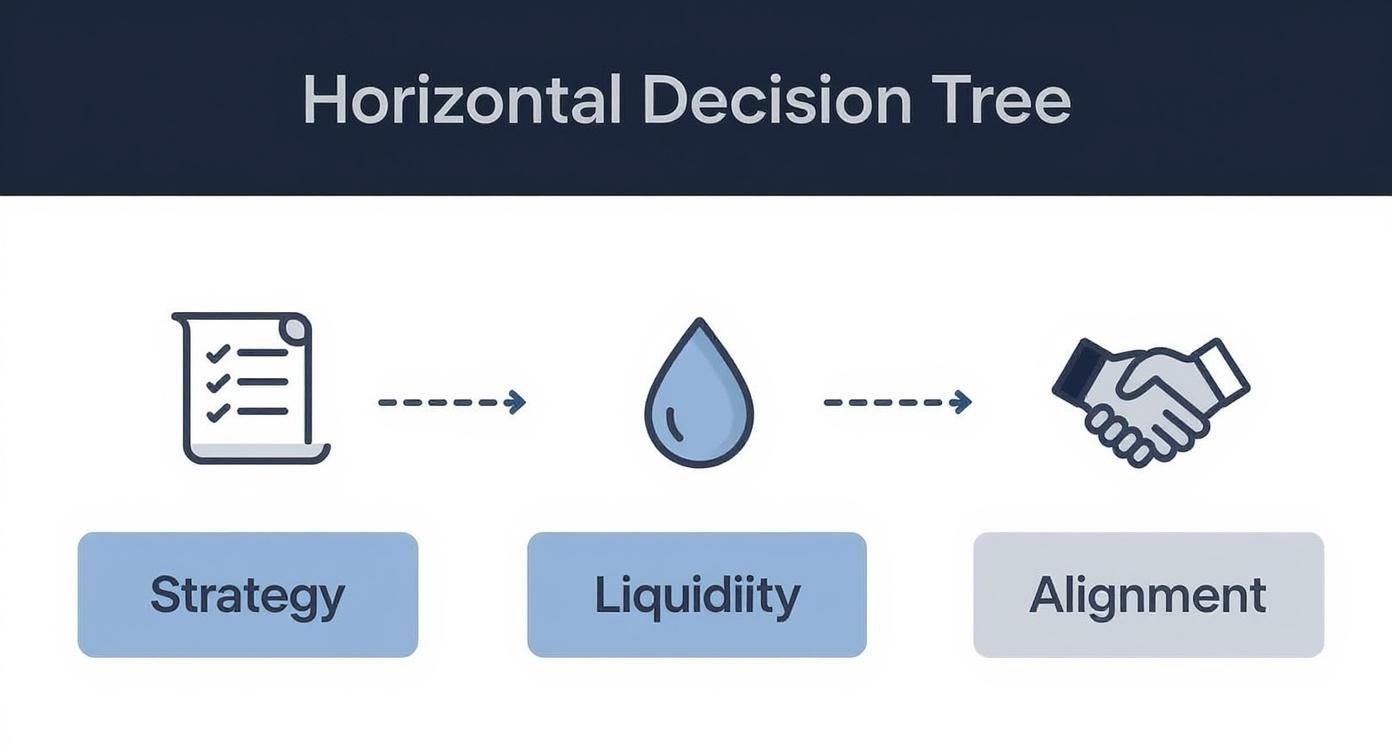
As the visual shows, your first question should always be about the investment thesis. That core idea dictates the liquidity profile needed to succeed, which ultimately points you to the right fund structure.
The Evolving Fund Landscape
The traditional closed-end fund (CEF) market shows just how much things are changing. According to data from Morningstar as of late 2023, the number of CEFs has been in a long-term decline, driven by conversions and liquidations. This isn't a sign of failure; it’s an evolution, with many converting to more flexible structures to meet modern investor demands.
This shift has given rise to hybrid and evergreen funds, which try to blend the long-term focus of a closed-end structure with the periodic liquidity of an open-ended one. They can be promising, but you have to do your homework on their specific redemption terms and gates.
Beyond just the fund structure, it's about how these investments fit into your bigger picture. Exploring different wealth building strategies can help you see where these funds fit and how to best reach your long-term goals. Ultimately, whether it's open, closed, or a hybrid, both structures can play a vital role in a diversified portfolio—as long as they're matched with the right strategy and a great sponsor.
Common Questions from Investors
When you're digging into the world of private real estate funds, a few key questions always seem to pop up. Here are some of the most common ones we hear from accredited investors and family offices trying to decide between an open-ended or closed-ended structure.
Can a Closed Ended Fund Become an Open Ended Fund?
It can, and the process is known as "open-ending." This is a major shift, usually pushed by investors who are tired of seeing their shares trade at a discount to the fund's actual Net Asset Value (NAV). By converting, the fund gets rid of its fixed share count and starts issuing and buying back shares directly at NAV.
But this isn't always a silver bullet. For a fund tied up in illiquid assets, like a multi-year development project, being forced to sell property at the wrong time just to cover redemptions could completely derail the original strategy. It's a move that can seriously hurt the long-term investors who decide to stick around.
Are Fees Different for Open Ended vs Closed Ended Funds?
Yes and no. The fee structure usually has more to do with the investment strategy inside the fund than the fund type itself, but there are some common patterns. For closed-ended funds, especially those chasing higher returns in the value-add or opportunistic space, the classic "2 and 20" model is king. That means a 2% management fee on the assets and a 20% cut of the profits (the "promote") above a set return hurdle.
On the other hand, open-ended funds that hold more stable, cash-flowing properties tend to have lower management fees and often skip the performance fee altogether. The bottom line for any investor: get your hands on the Private Placement Memorandum (PPM) and read the fine print. Fees are one of the biggest factors that will eat into your net returns, regardless of the structure.
Why Would an Investor Choose a Fund with Limited Liquidity?
It might sound counterintuitive, but sophisticated investors often seek out illiquid closed-ended funds for one simple reason: access to higher potential returns. Think ground-up development or a major property repositioning—these aren't quick flips. The fund structure's greatest strength is giving the manager "patient capital."
A fixed pool of capital means the manager can actually execute a long-term business plan without the constant threat of having to sell assets early to pay out departing investors. In exchange for tying up their money, investors are targeting an "illiquidity premium"—the extra return you can potentially earn for taking on risk that public market investors won't touch.
How Does Leverage Work Differently in These Fund Types?
Both fund types use debt to boost returns, but how they manage it is worlds apart. A closed-ended fund works with a fixed, stable capital base. This allows the manager to lock in debt with predictable terms that align with the long-term hold period of the assets.
An open-ended fund also uses leverage, but its ever-changing capital base makes things much trickier. A sudden wave of redemption requests could force the fund to sell assets into a down market just to pay back its lenders. It's a structural risk that closed-ended funds are specifically designed to avoid.
Take the Next Step
Well-structured real estate can be a prudent, resilient component of a long-term wealth strategy. Understanding the nuances of fund structures is the first step toward making an informed allocation. If you’re an accredited investor looking to diversify into institutional-quality real estate, we should talk.
Schedule a confidential call with Stiltsville Capital to discuss how our disciplined approach to value-add and opportunistic real estate may fit your portfolio goals.
Information presented is for educational purposes only and does not constitute an offer to sell or a solicitation of an offer to buy securities. Any offering is made only through definitive offering documents (e.g., private placement memorandum, subscription agreement) and is available solely to investors who meet applicable suitability standards, including “Accredited Investor” status under Rule 501 of Regulation D. Investments in private real estate involve risk, including loss of capital, illiquidity, and no guarantee of distributions. Past performance is not indicative of future results. Verification of accredited status is required for participation in Rule 506(c) offerings.






